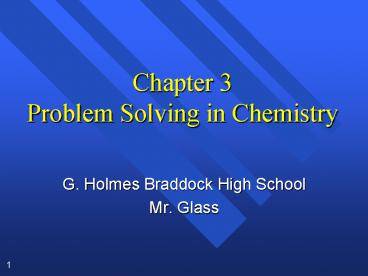Chapter 3 Problem Solving in Chemistry - PowerPoint PPT Presentation
1 / 29
Title:
Chapter 3 Problem Solving in Chemistry
Description:
Title: Chapter 4 - Problem Solving Author: Dr. Stephen L. Cotton Last modified by: jgeary Created Date: 10/8/1995 4:27:04 PM Document presentation format – PowerPoint PPT presentation
Number of Views:173
Avg rating:3.0/5.0
Title: Chapter 3 Problem Solving in Chemistry
1
Chapter 3Problem Solving in Chemistry
- G. Holmes Braddock High School
- Mr. Glass
2
Section 3.1 Word Problems
- The laboratory does not give you numbers already
plugged into a formula - You have to decide how to get the answer.
- Like word problems in math.
- The chemistry book gives you word problems (just
like real life!)
3
Section 3.2 Techniques of Problem Solving
- OBJECTIVES
- List five steps used in solving problems.
- Describe the five-step problem-solving approach.
4
3.2 Problem solving
- 1. ANALYZE
- a) Identify the unknown
- Both in words and what units it will be
measured in. Write it down! - May need to read the question several times.
- b) Identify what is given (the known)
- Write it down!
- Unnecessary information may also
be given
5
3.2 Problem solving
- c) Plan a solution
- The heart of problem solving
- Break it down into steps.
- Look up needed information
- Tables
- Formulas
- Constants, or conversion factors
- Choose an equation
6
Problem solving
- CALCULATE
- doing the arithmetic use of calculator?
- 3. EVALUATE
- Round off to proper of sig. figs.
- Proper units? Need Scientific Notation?
- Check your work!
- Reread the question, did you answer it?
- Is it reasonable?
- Estimate an approximate answer
7
Example of Problem Solving
- Remember to
- Analyze
- Calculate
- Evaluate
- Example 1, page 62
8
Section 3.3Simple Conversion Problems
- OBJECTIVES
- Construct conversion factors from equivalent
measurements.
9
Section 3.4 Dimensional Analysis
- OBJECTIVES
- Apply the techniques of dimensional analysis to a
variety of conversion problems.
10
Conversion factors
- A ratio of equivalent measurements
- Start with two things that are the same
- one meter is one hundred centimeters
- write it as an equation
- 1 m 100 cm
- can divide by each side to come up with two ways
of writing the number 1
11
Conversion factors
12
Conversion factors
1
1 m
100 cm
13
Conversion factors
1
1 m
100 cm
14
Conversion factors
1
1 m
100 cm
100 cm
1
1 m
15
Conversion factors
- A unique way of writing the number 1
- In the same system they are defined quantities so
they have unlimited significant figures - Equivalence statements always have this
relationship - big small unit small big unit
- 1000 mm 1 m
16
Write the possible conversion factors for the
following
- Between kilograms and grams
- between feet and inches
- using 1.096 qt. 1.00 L
17
What are they good for?
- We can multiply by one creatively to change the
units . - 13 inches is how many yards?
- 36 inches 1 yard.
- 1 yard 1 36 inches
- 13 inches x 1 yard 36 inches
18
What are they good for?
- We can multiply by a conversion factor to change
the units . - Problem 13 inches is how many yards?
- Known 36 inches 1 yard.
- 1 yard 1 36 inches
- 13 inches x 1 yard 0.36 yards
36 inches
19
Conversion factors
- Called conversion factors because they allow us
to convert units. - really just multiplying by one, in a creative
way. - Try Practice Problem 9 on p. 64.
20
Dimensional Analysis
- A way to analyze and solve problems, by using
units (or dimensions) of the measurement - Dimension unit (such as g, L, mL)
- Analyze solve
- Using the units to solve the problems.
- If the units of your answer are right, chances
are you did the math right!
21
Dimensional Analysis
- A ruler is 12.0 inches long. How long is it in
cm? ( 1 inch 2.54 cm) - in meters?
- A race is 10.0 km long. How far is this in miles?
- 1 mile 1760 yds
- 1 meter 1.094 yds
- Pikes peak is 14,110 ft. above sea level. What is
this in meters?
22
Dimensional Analysis
- Another measuring system has different units of
measure 6 ft 1 fathom 100 fathoms
1 cable length 10 cable lengths 1 nautical
mile 3 nautical miles 1 league - Problem Jules Verne wrote a book 20,000 leagues
under the sea. How far is this in feet? - Try Practice Problem 10-12 on p. 68
23
Converting Between Units
- We often need to express a measurement in
different units from the one given or measured. - Use dimensional analysis!
- Remember to
- Analyze
- Calculate
- Evaluate
24
Converting Between Units
- Do Pr. Problems 13-14 on p. 70.
- Do Pr. Problems 15-17 on p.70.
25
Section 3.6More Complex Problems
- OBJECTIVES
- Solve problems by breaking the solution into
steps.
26
Section 3.7More Complex Problems
- OBJECTIVES
- Convert complex units, using dimensional analysis.
27
Multistep Problems
- Many complex tasks in daily life are handled by
breaking them down into manageable parts - Consider cleaning a car
- vacuum the inside
- wash the exterior
- dry the exterior
- apply a coat of wax
28
Multistep Problems
- When converting between units, it is often
necessary to use more than one conversion factor. - Try Practice Problems 21 22 on p. 74.
29
Converting Complex Units
- By complex, we mean units that may be expressed
as a ratio - speed is miles/hour
- gas mileage is miles/gallon
- density is g/cm3
- Try Practice Problems 23-25 on p. 76.































